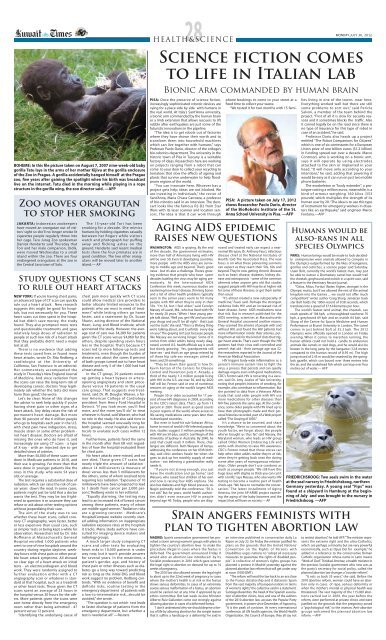UAE widENS cRAckdOwN; MORE ISlAMiStS ... - Kuwait Times
UAE widENS cRAckdOwN; MORE ISlAMiStS ... - Kuwait Times
UAE widENS cRAckdOwN; MORE ISlAMiStS ... - Kuwait Times
Create successful ePaper yourself
Turn your PDF publications into a flip-book with our unique Google optimized e-Paper software.
BOHEME: In this file picture taken on August 7, 2007 nine-week-old baby<br />
gorilla Tatu lays in the arms of her mother Kijivu at the gorilla enclosure<br />
of the Zoo in Prague. A gorilla accidentally hanged himself at the Prague<br />
zoo, five years after gaining the spotlight when his birth was broadcast<br />
live on the internet. Tatu died in the morning while playing in a rope<br />
structure in the gorilla wing, the zoo director said. —AFP<br />
Zoo moves orangutan<br />
to stop her smoking<br />
JAKARTA: Indonesian zookeepers<br />
have moved an orangutan out of visitors’<br />
sight so she’ll no longer smoke lit<br />
cigarettes people regularly throw into<br />
her cage. Taru Jurug Zoo spokesman<br />
Daniek Hendarto said Thursday that<br />
Tori and her male companion, Didik,<br />
were moved Wednesday to a small<br />
island within the zoo. There are four<br />
endangered orangutans at the zoo in<br />
the Central Java town of Solo.<br />
NEW YORK: If you’re having chest pains,<br />
an advanced type of CT scan can quickly<br />
rule out a heart attack. New research<br />
suggests this might be good for hospitals,<br />
but not necessarily for you. These<br />
heart scans cut time spent in the hospital<br />
but didn’t save money, the study<br />
found. They also prompted more tests<br />
and questionable treatments and gave<br />
relatively large doses of radiation to<br />
people at such low risk of a heart attack<br />
that they probably didn’t need a major<br />
test at all.<br />
There is no evidence that adding<br />
these tests saved lives or found more<br />
heart attacks, wrote Dr. Rita Redberg, a<br />
cardiologist at the University of<br />
California, San Francisco in an editorial.<br />
Her commentary accompanied the<br />
study in Thursday’s New England Journal<br />
of Medicine. And since radiation from<br />
the scans can raise the long-term risk of<br />
developing cancer, doctors “may legitimately<br />
ask whether the tests did more<br />
harm than good,” she wrote.<br />
Let’s be clear: None of this changes<br />
the advice to seek help quickly if you’re<br />
having chest pain or other signs of a<br />
heart attack. Any delay raises the risk of<br />
permanent heart damage. But more<br />
than 90 percent of the 6 million people<br />
who go to hospitals each year in the U.S.<br />
with chest pain have indigestion, stress,<br />
muscle strain or some other problem -<br />
not heart disease. Doctors are afraid of<br />
missing the ones who do have it, and<br />
increasingly are using CT scans - a type<br />
of X-ray - with an injected dye to get<br />
detailed views of arteries.<br />
More than 50,000 of these scans were<br />
done in Medicare patients in 2010, and<br />
their use is growing. Far more than that<br />
were done in younger patients like the<br />
ones in this study, who were 54 years<br />
old, on average.<br />
The test requires a substantial dose of<br />
radiation, which can raise the risk of cancer<br />
years down the road. In some cases,<br />
patients might just be told that a doctor<br />
wants the test. They may be too frightened<br />
to question it or unaware they can<br />
refuse or ask about other testing options<br />
without jeopardizing their care.<br />
The aim of the study was to see<br />
whether these heart scans, called coronary<br />
CT angiography, were faster, better<br />
or less expensive than usual care, such<br />
as simpler tests or being kept a while for<br />
observation. Researchers led by Dr. Udo<br />
Hoffmann at Massachusetts General<br />
Hospital enrolled 1,000 patients who<br />
went to one of nine hospitals around the<br />
country during regular daytime, weekday<br />
hours with chest pain or other possible<br />
heart attack symptoms. All showed<br />
no clear sign of a heart attack on initial<br />
tests - an electrocardiogram and blood<br />
work. They were randomly assigned to<br />
further evaluation either with a CT<br />
angiography scan or whatever is standard<br />
at that hospital, such as a treadmill<br />
or other heart tests. Those given the CT<br />
scans spent an average of 23 hours in<br />
the hospital versus 30 hours for the others.<br />
More patients given the scans were<br />
sent home directly from the emergency<br />
room rather than being admitted - 47<br />
percent versus 12 percent.<br />
“Identifying the underlying cause of<br />
The 15-year-old Tori has been<br />
smoking for a decade. She mimics<br />
humans by holding cigarettes casually<br />
between her fingers while visitors<br />
watch and photograph her puffing<br />
away and flicking ashes on the<br />
ground. Hendarto said recent medical<br />
tests show the four primates are in<br />
good condition. The two other orangutans<br />
will be moved later to another<br />
island.— AP<br />
Study questions CT scans<br />
to rule out heart attacks<br />
chest pain more quickly with CT scans<br />
could allow medical care providers to<br />
better allocate limited resources to the<br />
patients who are most in need of treatment”<br />
while letting others go home<br />
faster, said a statement by Dr. Susan<br />
Shurin, acting director of the National<br />
Heart, Lung, and Blood Institute, which<br />
sponsored the study. However, the average<br />
cost of care was $4,289 for patients<br />
given the CT scans versus $4,060 for the<br />
others, despite spending seven hours<br />
less in the hospital. That’s because CT<br />
scans led to more follow-up tests and<br />
treatments, even though the burden of<br />
disease was about the same; 8 percent<br />
of both groups turned out to have heart<br />
disease and only 5 of the 1,000 had had<br />
a heart attack.<br />
In the CT group, 29 patients wound<br />
up getting a heart bypass or arteryopening<br />
angioplasty and stent procedures<br />
versus 18 patients in the usual<br />
care group. That suggests overtreatment,<br />
said Dr. W. Douglas Weaver, a former<br />
American College of Cardiology<br />
president from Henry Ford Hospital in<br />
Detroit. “If you look more, you’ll find<br />
more, and the more you’ll do” to treat<br />
whatever is found, said Weaver, who had<br />
no role in the study. He also said time in<br />
the hospital seemed unusually long for<br />
both groups - most hospitals have protocols<br />
to evaluate such cases within 12<br />
hours.<br />
Furthermore, patients fared the same<br />
in the month after their ER visit regardless<br />
of how the hospital evaluated them<br />
for chest pain.<br />
No heart attacks were missed, and no<br />
one died. Those given CT scans had<br />
nearly triple the amount of radiation -<br />
about 14 millisieverts (a measure of<br />
dose) versus less than 5 millisieverts for<br />
the others, some of whom received tests<br />
requiring less radiation. “Exposures of 10<br />
millisieverts have been projected to lead<br />
to 1 death from cancer per 2,000 persons,”<br />
Redberg wrote in her editorial.<br />
“Equally alarming, the testing may<br />
lead to an increased risk of breast cancer<br />
among these patients, many of whom<br />
are middle-aged women.” Radiation risks<br />
are a growing concern - Medicare’s<br />
HospitalCompare website recently started<br />
adding information on inappropriate<br />
radiation exposure rates at the hospitals<br />
it tracks. Many study authors have consulted<br />
for imaging device makers and<br />
radiology groups.<br />
A much larger study comparing CT<br />
scans and other tests for evaluating<br />
heart risks in 10,000 patients is under<br />
way now, but it won’t provide answers<br />
for several years. In the meantime, a<br />
patient’s gender, age, and history of<br />
chest pain or other illnesses such as diabetes<br />
go a long way toward predicting<br />
risk as long as the initial EKG and blood<br />
work suggest no problem, Redberg contends.<br />
“With no evidence of benefit and<br />
definite risks, routine testing in the<br />
emergency department of patients with<br />
a low-to-intermediate risk...should be<br />
avoided,” she wrote.<br />
“The question is not which test leads<br />
to faster discharge of patients from the<br />
emergency department, but whether a<br />
test is needed at all.” —Reuters<br />
HEALTH&SCIENCE<br />
PISA: Once the preserve of science fiction,<br />
increasingly sophisticated robotic devices are<br />
vying for a place side by side with humans in<br />
the real world. At Italy’s Sant’Anna university,<br />
a bionic arm commanded by the human brain<br />
or a limb extension that allows rescuers to lift<br />
rubble after earthquakes are just some of the<br />
futuristic innovations in the pipeline.<br />
“The idea is to get robots out of factories<br />
where they have shown their worth and to<br />
transform them into household machines<br />
which can live together with humans,” says<br />
Professor Paolo Dario, director of the college’s<br />
bio-robotics department. The university in the<br />
historic town of Pisa in Tuscany is a veritable<br />
factory of ideas. Researchers here are working<br />
on projects ranging from a robot that can<br />
come to your door to collect your recycling to<br />
tomatoes that slow the effects of ageing and<br />
plants that survive underwater to help floodprone<br />
regions of the world.<br />
“You can innovate here. Whoever has a<br />
project gets help, ideas are not blocked. We<br />
are investing in individuals,” the rector of<br />
Sant’Anna, Maria Chiara Carrozza, a professor<br />
of bio-robotics said in an interview. The dustcart<br />
looks like the famous R2-D2 from Star<br />
Wars with its laser scanner and location sensors.<br />
The idea is that it can work through<br />
phone bookings to come to your street at a<br />
fixed time to collect your waste.<br />
“We tested it for two months with 15 fami-<br />
MONDAY, JULY 30, 2012<br />
Science fiction comes<br />
to life in Italian lab<br />
Bionic arm commanded by human brain<br />
PISA: A picture taken on July 17, 2012<br />
shows Researcher Paolo Dario, director<br />
of the BioRobotic Institute of the St.<br />
Anna School University in Pisa. —AFP<br />
Aging AIDS epidemic<br />
raises new questions<br />
WASHINGTON: AIDS is graying. By the end<br />
of the decade, the government estimates,<br />
more than half of Americans living with HIV<br />
will be over 50. Even in developing countries,<br />
more people with the AIDS virus are surviving<br />
to middle age and beyond. That’s good<br />
news - but it’s also a challenge. There’s growing<br />
evidence that people who have spent<br />
decades battling the virus may be aging prematurely.<br />
At the International AIDS<br />
Conference this week, numerous studies are<br />
examining how heart disease, thinning bones<br />
and a list of other health problems typically<br />
seen in the senior years seem to hit many<br />
people with HIV when they’re only in their<br />
50s. “I’m 54, but I feel older,” said Carolyn<br />
Massey of Laurel, Md., who has lived with HIV<br />
for nearly 20 years. “When I hear young people<br />
talk about, ‘Well you get HIV and you take<br />
your drugs and you’ll be all right’ - that’s just<br />
not the truth,” she said. “This is a lifelong thing<br />
we’re talking about, and it unfolds every day<br />
on you.” The graying isn’t just because people<br />
like Massey are surviving longer. Some of it<br />
comes from older adults being newly diagnosed,<br />
a trend U.S. health officials say is small<br />
but slowly growing. Yes, grandparents still<br />
have sex - and that’s an age group missed by<br />
all those hip safe-sex messages aimed at<br />
teens and 20-somethings.<br />
“They let down their guard,” is how Dr.<br />
Kevin Fenton of the Centers for Disease<br />
Control and Prevention puts it. Already, a<br />
third of the nearly 1.2 million people living<br />
with HIV in the U.S. are over 50, and by 2020<br />
half will be, Fenton said at one of numerous<br />
sessions on aging at the world’s largest AIDS<br />
meeting.<br />
People 50 or older accounted for 17 percent<br />
of new HIV diagnoses in 2009, according<br />
to the CDC’s latest data. That’s up from 13<br />
percent in 2001. There aren’t as good counts<br />
in poor regions of the world, where access to<br />
life-saving medications came years later than<br />
in developed countries.<br />
But even in hard-hit sub-Saharan Africa,<br />
home to most of world’s HIV-infected population,<br />
studies suggest 3 million people living<br />
with HIV are 50-plus, said Dr. Joel Negin of the<br />
University of Sydney in Australia. By 2040, he<br />
said, that could reach 9 million. There, challenges<br />
are different. Ruth Waryaro of Kenya,<br />
addressing the conference on her 65th birthday,<br />
said clinic workers hassle her when she<br />
goes to pick up her monthly supply of medication<br />
- not believing a grandmother really<br />
needs it.<br />
“If you’re not strong enough, you just<br />
leave the medication and go home,” said<br />
Waryaro, who raised four children of her own<br />
and now is raising four AIDS orphans. She<br />
also has diabetes and high blood pressure. As<br />
Negin pointedly told the conference, “50 is<br />
not old.” But for years, world health authorities<br />
didn’t even measure HIV in people<br />
beyond age 49. Today, people who are diag-<br />
MADRID: Spain’s conservative government has provoked<br />
a storm among women’s groups with plans to<br />
tighten the country’s abortion laws to make the<br />
procedure illegal in cases where the foetus is<br />
deformed. The government announced Friday it<br />
would alter an abortion law introduced by its<br />
Socialist predecessors in 2010 which gave women<br />
the legal right to abortion on demand for up to 14<br />
weeks of pregnancy.<br />
The 2010 law also allowed women the legal right<br />
to abort up to the 22nd week of pregnancy in cases<br />
where the mother’s health is at risk or the foetus<br />
shows serious deformities. In cases of an extremely<br />
severe serious malformation of a foetus, an abortion<br />
could be carried out at any time if approved by an<br />
ethics committee. But last week Justice Minister<br />
Alberto Ruiz-Gallardon came out strongly against<br />
allowing abortion in cases of a deformed foetus.<br />
“I don’t understand why we should deprive a foetus<br />
of life by allowing abortion for the simple reason<br />
that it suffers a handicap or a deformity,” he said in<br />
nosed and treated early can expect a nearnormal<br />
life-span, Dr. Anthony Fauci, infectious<br />
disease chief at the National Institutes of<br />
Health, told The Associated Press. The new<br />
focus is on what these pioneering survivors<br />
can expect as they reach their 50s, 60s and<br />
beyond. They’re now getting chronic illnesses<br />
such as heart disease, diabetes, kidney disease<br />
and osteoporosis - some of the common<br />
ailments when anyone gets old. But studies<br />
suggest people with HIV may be at higher risk<br />
for some of those illnesses, or get them earlier<br />
than usual.<br />
“It’s almost created a new subspecialty of<br />
medicine,” Fauci said. Perhaps the strongest<br />
evidence links HIV and an increased risk of<br />
heart disease. Some AIDS medications raise<br />
that risk. But in research published for the<br />
AIDS meeting, scientists at Massachusetts<br />
General Hospital uncovered another reason.<br />
They scanned the arteries of people with and<br />
without HIV, and found the HIV patients had<br />
more inflammation inside their arteries, putting<br />
them at risk for the kind of clots that trigger<br />
heart attacks. That’s even though the HIV<br />
patients had their virus well-controlled and<br />
weren’t that old - their average age was 52,<br />
the researchers reported in the Journal of the<br />
American Medical Association.<br />
HIV triggers body-wide inflammation as a<br />
person’s immune system tries to fight the<br />
virus, a process that persists and can quietly<br />
damage organs even with good medications,<br />
CDC’s Fenton said. HIV is not acting in a vacuum,<br />
said Dr. Amy Justice of Yale University,<br />
noting that people’s histories of smoking, for<br />
example, also contribute to inflammation. But<br />
she pointed to data from a Veterans Affairs<br />
study that said older people with HIV use<br />
more medications for other diseases than<br />
HIV-free patients the same age. At the conference,<br />
some older people with HIV lined up to<br />
have their photographs made and their personal<br />
histories recorded, part of a Web project<br />
called “The Graying of AIDS.”<br />
It’s a chance to be counted, and share<br />
knowledge. “We’re so concerned about the<br />
youth factor, we forget about the people<br />
who’ve brought us thus far,” said Massey, the<br />
Maryland woman, who leads an HIV group<br />
called Older Women Embracing Life and<br />
works with churches to raise HIV awareness.<br />
CDC’s Fenton noted that those voices can<br />
help other older adults realize they’re at risk,<br />
when they’re getting back onto the dating<br />
scene after years of monogamous relationships.<br />
Older people don’t use condoms as<br />
much as younger people. “We still have this<br />
huge issue with stigma so thick you can cut it<br />
with a knife,” says Massey, who also wants HIV<br />
testing to become a routine part of health<br />
check-ups. “We have to normalize the conversation.”<br />
The latest installment of Aging<br />
America, the joint AP-APME project examining<br />
the aging of the baby boomers and the<br />
impact that will have on society.— AP<br />
an interview published in conservative daily La<br />
Razon on July 22. On Friday the minister justified his<br />
plans on the grounds that the United Nations’<br />
Convention on the Rights of Persons with<br />
Disabilities urges nations to “adopt all necessary<br />
measures to guarantee the rights of disabled people”.<br />
A collective of women’s rights groups has<br />
planned a protest in Madrid yesterday against the<br />
planned abortion law reform that will get under way<br />
at noon (1000 GMT).<br />
“The reform will send the law back to an era close<br />
to the Franco dictatorship and it distances Spain<br />
from the vast majority of European nations in terms<br />
of women’s rights,” the collective said in a statement.<br />
Santiago Barambio, the head of the Spanish association<br />
of abortion clinics, Acai, and one of the authors<br />
of the 2010 abortion law, accuses the Popular Party<br />
government, in power since December, of hypocrisy.<br />
“It is the peak of cynicism. At every international<br />
conference, all UN health agencies, the World Health<br />
Organisation, the Council of Europe, they all say not<br />
lies living in one of the towns near here.<br />
Everything worked well but there are still<br />
some problems to sort out,” said Pericle<br />
Salvini, a member of the team behind the<br />
project. “First of all it is slow for security reasons<br />
and it sometimes blocks the traffic. Also<br />
it cannot legally be on the road since there is<br />
no type of insurance for this type of robot in<br />
case of an accident,” he said.<br />
Professor Dario also heads up a project<br />
entitled “The Robot Companions for Citizens”<br />
which is one of six contestants for a European<br />
Union prize of one billion euros ($1.2 billion)<br />
in funding spread out over a decade. Marco<br />
Controzzi, who is working on a bionic arm,<br />
says it will operate by using electrodes<br />
attached to the skin or implanted in your<br />
head. “It will move only according to your<br />
intentions,” he said, adding that powering it<br />
would be easy as it can run on just two mobile<br />
phone batteries.<br />
The exoskeleton or “body extender”, a prototype<br />
costing a million euros, meanwhile, is a<br />
kind of armour weighing 160 kilos (353<br />
pounds) which multiplies the strength of its<br />
human user by 20. “The idea is to use this type<br />
of instrument for emergency workers in disasters<br />
like an earthquake,” said engineer Marco<br />
Fontana.—AFP<br />
Humans would be<br />
also-rans in all<br />
species Olympics<br />
PARIS: Human beings would be made to look decidedly<br />
unimpressive were animals allowed to compete in<br />
the Olympics-outperformed by the likes of kangaroos,<br />
gorillas and ostriches, a science paper said Saturday.<br />
Usain Bolt, currently the world’s fastest man, may just<br />
be able to outrun a Dromedary camel but would trail<br />
the cheetah, greyhound and ostrich in a sprint race, said<br />
a feature in the Veterinary Record journal.<br />
“‘Citius, Altius, Fortius’ (faster, higher, stronger) is the<br />
Olympic motto, but if we allowed the rest of the animal<br />
kingdom into the Games ... we could not offer much<br />
competition!” wrote author Craig Sharp. Jamaican track<br />
star Bolt holds the 100m-record of 9.58 seconds, which<br />
translates into a speed of 37.6 kilometres per hour.<br />
The world’s fastest land animal, the cheetah, can<br />
reach speeds of 104 kph, a thoroughbred racehorse 70<br />
kph, a greyhound 69 kph and an ostrich 64 kph, said<br />
Sharp of the Centre for Sports Medicine and Human<br />
Performance at Brunel University in London. The camel<br />
comes in just behind Bolt at 35.3 kph. The 2012<br />
Olympics were officially opened in London on Friday<br />
evening. When it comes to marathon running, the<br />
human athlete could not hold a candle to endurance<br />
animals like camels or sled dogs, and he would also be<br />
beaten in the long jump by the kangaroo (12.8 meters<br />
compared to the human record of 8.95 m). The high<br />
jump record of 2.45 m would be smashed by the springbok<br />
gazelle, which can bound over three metres into<br />
the air, and the snakehead fish which can leap over four<br />
metres out of water.— AFP<br />
FRIEDRICHSKOOG: Two seals swim in the water<br />
at the seal nursery in Friedrichskoog, northern<br />
Germany yesterday. A young seal “Fips” was<br />
found at a shipyard in Hamburg at the beginning<br />
of July and was brought to the nursery in<br />
Friedrichskoog. —AFP<br />
Spain angers feminists with<br />
plan to tighten abortion law<br />
to restrict abortion,” he told AFP. “The minister represents<br />
the extreme right and the ultra-Catholics,<br />
which are perhaps a minority but are very powerful<br />
economically, such as Opus Dei for example,” he<br />
added in a reference to the conservative Roman<br />
Catholic organisation whose name in Latin means<br />
“Work of God”. Trinidad Jimenez, a health minister in<br />
the previous Socialist government who now acts as<br />
the party’s secretary for social policy, called the<br />
planned abortion law changes a “counter-reform”.<br />
“It sets us back 35 years,” she said. Before the<br />
2010 abortion reform, women could have an abortion<br />
only in cases of rape, serious deformity or<br />
when the mother’s mental or physical health was<br />
threatened. The vast majority of the 115,000 abortions<br />
carried out in 2009, the year before the<br />
reform, were performed at private clinics and were<br />
justified on the grounds that the pregnancy posed<br />
a “psychological risk” to the woman. Anti-abortion<br />
groups welcomed the planned abortion law<br />
reform. —AFP

















